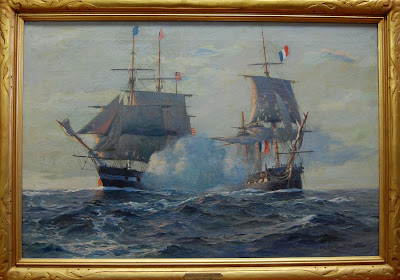--John Pentangelo, Curator/Registrar
--Joshua Howard, Curatorial Volunteer
 |
| 1. LCDR J.H. Wellings aboard USS Strong, 7 Aug 1942 |
Among the many personal items donated to the museum by the men and women who served in the United States Navy is a broken wrist watch with an amazing story to tell. It's owner, Rear Admiral Joseph H. Wellings (1903-1988) had a close tie to the region during his career. Born into a naval family in Massachusetts, he was a student and staff member at the Naval War College (1946-48), served as commander of the Newport Naval Base (1953-55) and twice served as commandant of the First Naval District (1954-55, 1962-63).
 |
| 2. USS Strong under way |
Before America's entry into World War II, Wellings was sent to London to serve as Assistant Naval Attaché. While in this post he served as Chief Operations Officer on the HMS
Rodney during the search and eventual sinking of the German battleship
Bismarck in May 1941. In 1942 Lt. Commander Wellings took command of a newly built Fletcher-class destroyer, the USS
Strong (DD-467).
Strong was sent to the Pacific and was involved in a number of engagements including the sinking of a Japanese submarine. On the 5 July 1943,
Strong was operating in Kula Gulf as part of a force of destroyers and cruisers supporting a pre-dawn marine landing on Rice Anchorage, New Georgia.
 |
3. A crew member on USS Helena photographs
USS Strong exploding after the torpedo attack. |
Shortly after midnight on the 5 July, when the ships ceased their bombardment, a Japanese torpedo slammed into
Strong's port side, destroying a fire room and engine room and ripping a hole in the side of the ship. The damaged destroyer began taking on water and listing. Explosions set fires below decks and some main deck plates collapsed. With a list of almost 45 degrees, Wellings gave the order to prepare to abandon ship. Moments later, at 0113, the USS
Chevalier (DD-451) steamed into view and slammed into the side of her sinking sister ship. She had cargo nets hanging over the sides in order to rescue as many of the crew as possible. Taking heavy fire from the shore during the rescue,
Chevalier saved the majority of the crew (234 enlisted men and seven officers) before being forced to head off. Certain his surviving crew were safe, Wellings decided to leave his command. At 0124, Wellings and a quartermaster, who refused to abandon ship until his commanding officer was ready,
stepped into the water. Moments later
Strong broke in two and sunk beneath the waves.
The two men did not have long to reflect as a 300 pound depth charge from the sunken vessel exploded and briefly knocked Wellings unconscious. The men climbed on one of
Strong's floater nets and attempted to make their way toward land when finally rescued by USS
Gwin (DD-433) at 0510. By Wellings's recollection, 46 of his men were lost during the attack.
 |
| 4. The Wellings Wrist Watch |
Wellings recovered and returned to the Pacific Theater, ultimately taking command of Destroyer Squadron 2 in 1944. In 1963, after a long and distinguished career in the United States Navy, Rear Admiral Wellings retired and settled in Newport. In 1980, he donated the wrist watch he wore the night
Strong went under to the Naval War College Museum. The stainless steel, Swiss-made watch manufactured by the Pierce Watch Co. is missing its protective crystal. The dial is damaged and the hands are frozen when the watch stopped working in the waters of Kula Gulf on 5 July 1943, but it remains a powerful reminder of the cost the United States bore to capture Rice Anchorage in 1943 and defeat Japan two years later.
 |
| 5. CDR Wellings points to a map indicating where USS Strong sunk |
1, 3, 5. Naval Historical Collection (NWC Archives)
2. Naval History and Heritage Command
4. Naval War College Museum







I was a Corpsman at Naval Hospital, Newport and Admiral Wellings was one of my charges in 1968. I have always regretted not having as much time as I wanted to sit with him and hear his fascinating tales of his service during WWII. In my research since then, I have come to realize that man was not prone to tell "sea stories," he told facts. He was truly an American Hero. May God bless his soul.
ReplyDeleteIf anyone visiting here has other personal stories about Gus Wellings or other men associated with the USS STRONG DD 467 and actions in the Kula Gulf, please contact me at tamber12@aol.com.
ReplyDeleteTammi Johnson, www.projectuss-strongdd467.com
I too had the honor of taken care of the admiral on SOQ ward in 68.he had a lovely daughter and always thanked the Corpmen that took care of him .
ReplyDelete